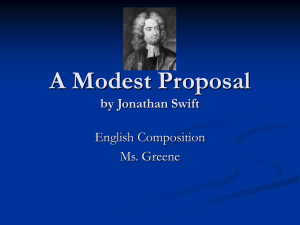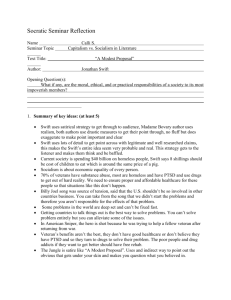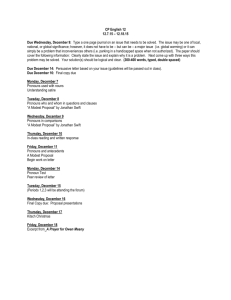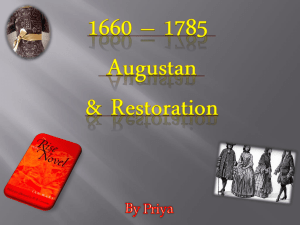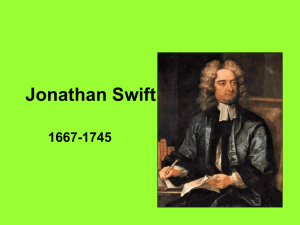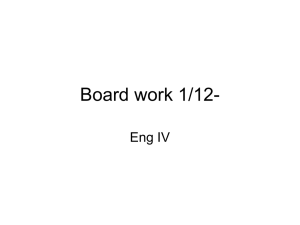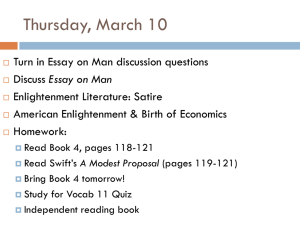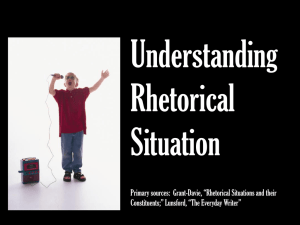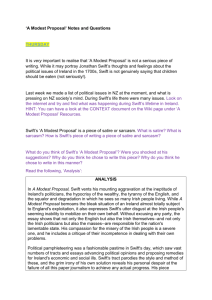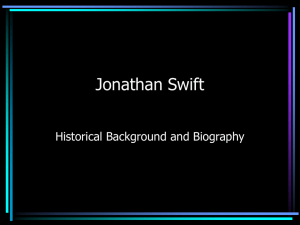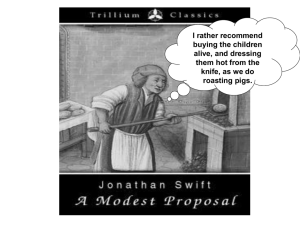A Modest Proposal by Jonathan Swift
advertisement
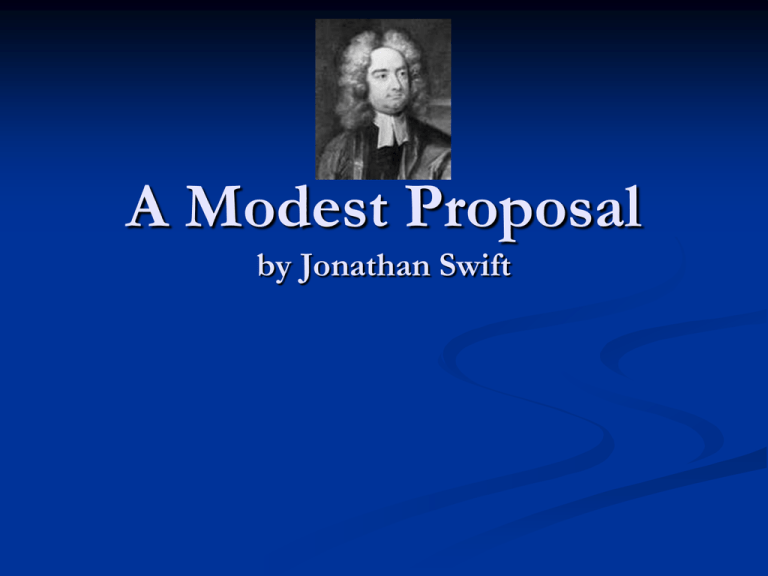
A Modest Proposal by Jonathan Swift Satire is a sort of glass, wherein beholders do generally discover everybody’s face but their own; which is the chief reason for that kind of reception it meets in the world and that so very few are offended with it. Jonathan Swift A MODEST PROPOSAL FOR PREVENTING THE CHILDREN OF POOR PEOPLE IN IRELAND, FROM BEING A BURDEN ON THEIR PARENTS OR COUNTRY, AND FOR MAKING THEM BENEFICIAL TO THE PUBLICK. And unless it wants to break from its social function, art must show the world as changeable. And help to change it. Max Ernst 1899-1972 The Age of Reason – 1660-1780 Swift wrote his satires during “The Age of Reason” In Europe in the late 17th to end of the 18th century, there was a general intellectual and literary movement known as the enlightenment. The movement is characterized by Rationalism – a philosophy that emphasized the role of reason rather than sensory experience or faith in answering basic questions of human existence. Concern regarding human existence led to a need to address social problems. This movement is sometimes known as the Neoclassical Age. OPENING OTHER’S EYES What if you had good ideas for solving a terrible social problem, but no one would listen to you? How would you get people’s attention? Jonathan Swift faced such a situation in the late 1720’s when starvation was widespread in Ireland. Irish harvests had been poor for years. Farmers couldn’t pay the rents demanded by their English landlords. Beggars and starving children filled the streets. England’s policies kept the Irish poor. Jonathan Swift (1667-1745) Well-known as the author of the satirical political fantasy, Gulliver's Travels. Swift published the “Modest Proposal” in 1729 as a pamphlet (a kind of essay in an unbound booklet). At this time, and for many years afterward, Ireland (not an independent country) was very poor. Most people born in Ireland were Roman Catholics & employed as agricultural laborers or tenant farmers. The landlords (landowners) were paid from the produce of the land at rates which the workers could rarely afford. The ruling class were usually Protestants Many of them were not born in Ireland, nor did they live there permanently If the laborers lost their work, there would always be other poor people to take it up There was no social security system and starvation was as common as in the Third World today Swift knows, in writing the Proposal, that in living memory, Irish people had been driven to cannibalism A Modest Proposal? Appalled by the misery in Ireland, Jonathan Swift set out to make the English more responsive to their neighbors’ suffering. The Modest Proposal begins by using vivid imagery to describe the very real poverty of people in Ireland. Swift presents this quite sympathetically but sets out facts and details, showing that there is a “surplus” of children who cannot be fed. With a masterful use of rhetorical (persuasive) devices, Swift, through the use of a persona/speaker, then: a. suggests solutions for the problem b. describes how the solution will benefit society c. addresses opposing points of view d. explains why his solution is the best. VOCABULARY Some of the unfamiliar terms in the Modest Proposal are explained below: Chair: (Here) a Sedan Chair - a covered chair supported by poles, carried by two bearers. Episcopal: To do with (here appointed by) a bishop - the adjective refers to church administration at the time Swift wrote. Gibbet: Place where criminals are hanged. Mandarin: Important official serving an oriental (originally Chinese) ruler, or any high official today. Papists: Supporters of the Pope, an insulting name for Catholics. Pretender: James Stuart, a Catholic who pretended to (claimed) the English and Scottish thrones. He is sometimes known as the Old Pretender, while his son, Charles Edward Stuart, is known as the Young Pretender (or Bonnie Prince Charlie) Shambles: Place (usually in a town) where animals are slaughtered and butchered. Solar year: A year in the ordinary sense (as measured by the earth's going once round the sun). Other words to know: .1. importune 6. emulate 2. raiment 7. expedient 3. repine 8. parsimony 4. gibbet 9. animosity 5. vintner 10. overture Rhetoric Review Rhetoric is the art of persuasion. It is the effort on the part of the speaker or writer to take full advantage of the communication process in order to bring about a change of thinking or acting on the part of the listener or reader. Rhetoric may be reflected in the efforts of the speaker or writer to communicate: Some aspects of a self image Some emphasis of line of reasoning in the message or argument Some appeal to rational or emotional response of the audience. Rhetorical Devices – Page 1 Satire: A literary manner that blends a critical attitude with HUMOR and WIT for the purpose of improving human institutions or humanity. True satirists are conscious of the frailty of human institutions and attempt through laughter not so much to tear them down as to inspire a remodeling. Irony and sarcasm are often used in satire. Irony: A contrast between what appears to be and what really is. In verbal irony, words imply the opposite of what they literally mean. Voice/persona: The “voice” comes from the narrator in a piece of writing. The voice is not necessarily the writer – he/she may create a persona to put forth opinions and ideas opposite to the writer’s personal opinions. Rhetorical Devices - Page 2 The - Image of the Speaker The speaker may attempt to reflect a variety of images of self in order to gain a positive or credible image. Some possible categories may be: well educated - concerned citizen sincere - common sense just plain folks - humorous & sharp witted well organized - altruistic Rhetorical Devices – Page 3 A Reader’s Response The reader or listener responds to various ways that the message is styled to elicit a range of responses. The speaker or writer manipulates language in order to attract attention. Some techniques are: - - Rhetorical questions Figures of speech Repetition - Allusion - sentence variety - striking imagery With persuasive writing, the writer must also ANTICIPATE OPPOSING POINTS OF VIEW by addressing the COUNTERARGUMENT - If the speaker or writer acknowledges that there are opposing arguments and answers them, then the reader or listener will be more convinced of the argument. Rhetorical Devices – Page 4 “A Modest Proposal” is a classic example of persuasive writing used for the purpose of satire. Watch for these persuasive techniques: 1. LOGICAL APPEALS use evidence such as facts or statistics to support a position. 2. EMOTIONAL APPEALS use words that arouse strong feelings. Feelings could include: Joy Pride Fear Greed Hatred Love Respect Despair Anger Pity Shame Envy Faith Selflessness 3. ETHICAL APPEALS establish the writer’s sincerity and qualifications. Swift’s Rhetoric In addition watch out for: - irony - the image of the speaker - the use of a voice/persona - the use of rhetorical questions - a the use of allusion - the use of figures of speech – metaphors, similes, personification - sentence variety - repetition - striking imagery - how does Swift anticipate opposing points of view by addressing the counterargument? FINALLY What image of Swift and/or the speaker emerges after reading “A Modest Proposal?” Is Swift’s message clear and worthwhile? Does the work show a balance of reason (logos) and emotion (pathos)? PROBLEM The Modest Proposal begins by describing the very real poverty of people in Ireland. Swift presents this quite sympathetically but sets out facts and details, showing that there is a “surplus” of children who cannot be fed. He considers the possibility of selling the children into slavery, but objects to this - not because it is cruel or wrong, but because no-one will buy children below twelve years of age. This means that there is a long period in which the children cannot be fed, because their parents are too poor, but are too small and weak to be sold into work. SOLUTION? Next he digresses to make the shocking claim that, according to an American whom he knows, a healthy child at one year old is: “a most delicious, nourishing and wholesome Food, whether Stewed, Roasted, Baked or Boyled” SOLUTION From this beginning, Swift proceeds to develop his scheme by breeding children for food. For example, he states that landlords will be popular with tenants because they will be able to pay them more, to buy the children for the table. He reasons that, by selling their children so soon, mothers will be able to go back to work, until they produce the next child. He notes that, as Catholics seem to breed more rapidly than Protestants, his scheme will help reduce their numbers - as most of the children sold for food will be “Papists”, as he calls them. And he suggests that some purchasers will not only wish to eat the children, but will flay the skin and make gloves or boots from it, as from a fine leather. OPPOSING POINTS OF VIEW/COUNTER-ARGUMENT He moves to list six reasons why his scheme is a good one. Before concluding he advises people not to suggest other solutions - like taxing absentee landlords, of encouraging the domestic economy by buying Irish goods, of discouraging pride, vanity, idleness and gambling, and generally of expecting the wealthy to be more compassionate to the poor. He argues finally, that an early death would have been preferable to the misery many poor people experience in their adult lives. And he claims to be quite impartial, because his oldest child is nine and his wife past child-bearing - so that he will not be able to make any profit by selling his own children
